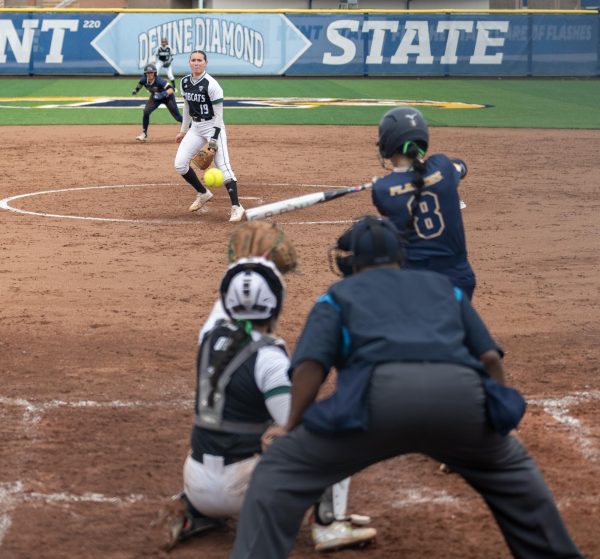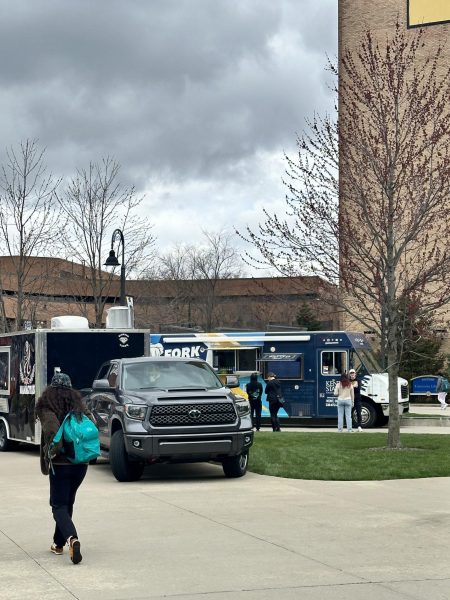Nothing 2 LOL about
March 13, 2008
States buckle down on cell phone use while driving to prevent distraction behind the wheel
Photo Illustration by David Foster
Credit: DKS Editors
Using cell phones while driving presents a big risk to anyone on the road. Accidents can happen, and some states have proposed laws to end the likelihood of danger.
The risk of being involved in a car accident is four times higher when drivers use cell phones. Both hand-held and hands-free cell phones involve the same risk, according to a research released by the Insurance Institute for Highway Safety.
The increase in the risk was the same for male and female drivers.
“The conversation itself appears to be the major distraction,” said Russ Rader, director of media relations of IIHS. “You’re conversing with someone else on the cell phone where you’re not paying full attention to the road.”
To minimize the risks of vehicle collisions for Ohio drivers, state representatives introduced House Bill 425.
| States with hand-held cell phone bans:
• California (effective July ’08) • Connecticut • District of Columbia • New Jersey – texting banned • New York • Washington – texting banned (effective July ’08) States with cell phone bans by jurisdiction: • Illinois • Massachusetts • Michigan • New Mexico • Ohio (cities like North Olmsted have banned hand-helds since 2002) • Pennsylvania Source: Governors Highway Safety Association – www.ghsa.org |
The bill would prohibit text messaging or typing on a mobile communication device when driving, Rep. Kathleen Chandler (D-68th) said. If approved it would establish the violation as a secondary traffic offense, meaning a driver would not be pulled over solely for this reason; however, Chandler said she would agree with the bill if it established the violation as a primary offense.
In 2006, the National Highway Traffic Safety Administration accounted 80 percent of all crashes in the nation to distracted drivers. Unaware drivers are not only cell phone users, but also those who put on makeup, read, watch a movie and shave, among others.
According to a NHTSA report, drivers involved in attention-related crashes are significantly younger and possess less driving experience.
“Young drivers are bigger risks behind the wheel than elderly drivers,” Rader said. “Young drivers are of course much more likely to be using devices that can be distracting like cell phones and iPods.”
In January 2007, a survey conducted by Nationwide Mutual Insurance Co. found 73 percent of 1,200 drivers talk on cell phones while driving; 19 percent of drivers admitted to sending text messages while sitting behind the wheel.
“Talking on a cell phone poses risks when you’re driving, and texting is even more risky,” Rader said. “You’re not only taking your mind off the road, but you’re also taking your eyes.”
To create awareness on the risks of unsafe driving, Champ Car World Series launched the global campaign Hands on the Wheel.
“(There are) a number of ways you can be distracted, whether it’s texting or talking on the phone,” said David Higdon, Champ Car World Series spokesman. “When you’re driving you need to be focused on the road, just like the drivers in Champ Car need to be focused in what they’re doing when they’re racing.”
Higdon said Champ Car drivers have visited different high schools and colleges in the United States to ask students to sign a pledge on safe driving.
The pledge could make a difference in awareness. As of February 2008, in the United States more than 230 million people use a cell phone, according to the Cellular Telecommunications & Internet Association.
The risk is there – be smart and think before picking up that phone.
Contact features correspondent Regina Garcia Cano at [email protected].
























